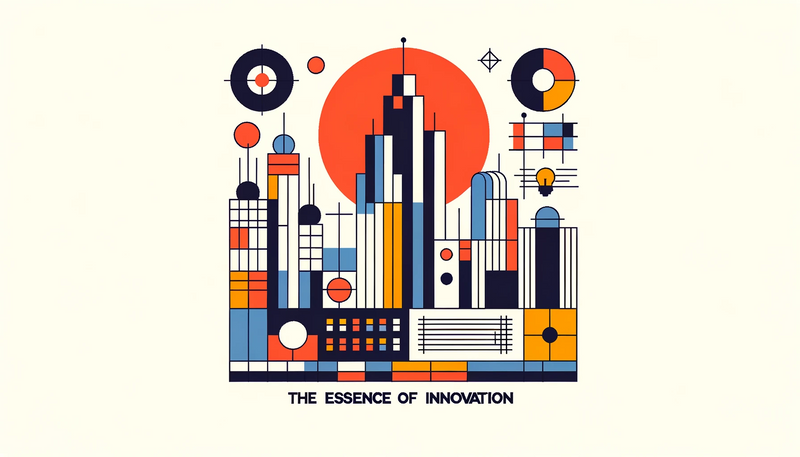The term 'innovation' has its roots in Latin, translating simply to the introduction of something novel. Over time, this concept has seamlessly woven itself into economic and business paradigms, particularly after J. Schumpeter's seminal work on "Creative Destruction" it has since evolved into a separate, vivid academic discipline.
In a business context, innovation is the ability to conceive, develop, deliver, and scale new products, services, processes, and business models for customers. To bridge the nuanced world of academic theories with the pragmatic sphere of businesses, it becomes essential to delve deeper into the distinction between 'invention' and 'innovation'.
An invention can be seen as the birth of a new idea, a novel product, service, process, or method. It's the conceptual phase, the eureka moment when a groundbreaking solution or method is conceived. However, the mere act of inventing doesn't guarantee its value in the real world. This is where innovation steps in. E.D. Roberts from the Center for MIT Entrepreneurship defines innovation as the product of invention and commercialization. To include non monetary value creation I suggest adapting the formula to:
"Innovation = Invention * Exploitation"

The true worth of an innovation is not just the brilliance of the original idea but how effectively it is executed in the market. An invention that remains dormant or fails in its market application remains just that, an invention. Whereas a successful market exploitation elevates an invention to the status of an successful innovation.
Actually the formula states the result being the product and not the sum. So without a new idea or without any exploitation the outcome is zero. Its the combination that makes them extraordinary valuable.
With this understanding, the act of innovating becomes much clearer. Innovating is a journey from idea to its selection, product development, marketing, operations, financing, and organizational management. In essence all actions to skilfully turn an idea into market successes.
Navigating the Complex Waters of Innovation Management
At its heart, the most important question in innovation is "WHY" and not "WHEN". Understanding the purpose and the driving force behind an innovation is crucial. Management revolves around the art of bringing people together to achieve specific goals and objectives, involving planning, organising, staffing, leading, and directing an entity's operations. However, when it comes to innovation, the aim is to be effective, not just efficient. This means creating real value and impact rather than just doing things quickly or cheap.
But Innovation management goes beyond managing tasks or rallying a team. It is also about creating an environment where creativity, the biggest differentiator, can thrive. And while accompanying a novel idea from inception to a successful market debut is essential, the biggest secret weapon in the innovator's arsenal is simulation. Yes, simulating gives teams a "digital wind tunnel" to to understand different scenarios and outcomes, and can help help anticipate challenges, strategies and possible outcomes of their decisions.
Having a solid, well-thought-out structure is further of utmost importance, ensuring that each phase of the innovation process is supported and interconnected. When this architecture is in place and combined with the right strategies and resources, the outcome can be exponential.
Yet, amidst all these strategies and structures, innovation managers face a sea of uncertainties, like changing customer preferences, technical feasibility, pricing strategies, and competitor movements. Navigating these challenges requires not only technical skills but also a deep understanding of organisational ones in financing, staffing, leadership, and governance All these efforts must be balanced within the available resources with a deep understanding of the market and its nuances.

Architecting the Blueprint of Innovation
Diving deeper into the insights of innovation, beyond simple bright ideas and market exploits, we unveil the intricate world of innovation architecture - the hidden secret behind many successful endeavours. Like constructing a resilient and functional building, fostering innovation demands architectural boldness. It's not solely about laying the foundation or designing aesthetic facades; it's about orchestrating every brick, every beam, and every room to create a harmonious, purpose-driven structure. This is where the art and science of architecting innovation come to the fore, ensuring that the entire house of innovation is meticulously designed and robustly engineered.
The house of innovation, as defined in innovation science, isn't just a metaphor but a holistic framework. It embodies the entirety of the innovation process, from the basement of foundational research and ideation to the rooftop of market realization and scaling. Each floor in between represents stages like conceptualization, development, testing, and commercialization. And like any architectural marvel, it requires careful planning, precision, and an understanding of the environment in which it stands.
A systematic and holistic innovation management approach ensures that no stone is left unturned. It recognizes that innovations don't thrive in isolation. They need spaces designed for teamwork, pathways for feedback, clear views of market trends, and opportunities for continuous improvement. Every part should work together seamlessly, ensuring a smooth and logical progression from one step to the next.

But why is this architectural mindset so important? Because real innovation is a multifaceted ecosystem. Overlooking even one element or underestimating the synergy of processes can lead to structural vulnerabilities. In the rapidly evolving world of startups and business ventures, these vulnerabilities can be costly.
In conclusion, to truly harness the potential of innovations, one must wear the hat of an architect. It's about viewing the grand picture while attending to minute details, ensuring that the house of innovation stands tall, resilient, and ready to weather the storms of market challenges - and all while shining brightly as a technological progress.
The author's mission is to master the craft of architecting innovation. It's not just about understanding its nuances but about pioneering paths and methodologies in its vast domain. And, dear reader, the very heart of this blog pulses with this dedication to collect, display and shape the framework of innovation - especially data centric ones.


